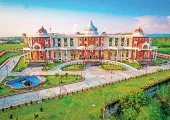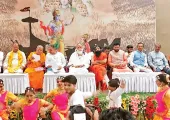Human Lifespan and Bio-Excellence
On

Dr Chandra Bahadur Thapa
Finance And Legal Advisor,
Indian Education Board And Law Advisor,
Patanjali Group Origin of life
5. Vivaswan Samvat (13,902 BC) Scholars believe that - this Panchag was around the deluge period, according to Surya Siddhanta mathematics it used to start from Chaitra Shukla Paksha.
6. Ikshvaku Samvat (8,576 BC) – was started by King Ikshvaku and it starts from Chaitra Shukla Pratipada.
7. Ancient Saptarshi Samvat (started from 6,676 BC).
8. Kalam Samvat (6,177 BC) It is also called Kollam Samvat and it is believed to be of the time of Parasurama Avatar.
9. Saptarshi Samvat (3,076 BC) till Mahabharata period - this Samvat was used. Later it gradually fell into oblivion. The credit for saving it goes to Kashmir and Himachal Pradesh. Saptarshi Samvat is called (cosmic Samvat) in Kashmir and Shastra Samvat in Jammu and Himachal Pradesh. Ever since the creation started, since then Saptarshi Samvat has come into existence. In ancient times, Saptarshi Samvat was used not only in India, but also in foreign countries. It is clear from the name itself that this Samvat has been named after the Saptarshi stars. There are a total of 27 constellations in the universe. The Saptarishis stay in each constellation for 100-100 years. In this way the Saptarishis complete one cycle every 2700 years. Another 18 years are added to this cycle to keep pace with the solar reckoning. That means there is a cycle of 2718 years. At the end of one cycle, a new count starts again. These 18 years are called Sarpakal. When the creation started, at that time the Saptarishis were on Shravan Nakshatra and nowadays they are on Ashwani Nakshatra.
10. Kaliyuga era 3102 BC. starts from The beginning of this Samvat is considered to be the departure of the Pandavas to the Himalayas by enthronement of Abhimanyu's son Parikshit and Lord Krishna's departure to Vaikunth.
11. The Jain-Yudhishthira Samvat (2,634 BC) began in the period of the eighth generation of Yudhishthira, starting from the month of Magha, after King Parshvanath of Kashi had retired. These were the Tirthankaras of Jainism.
12. The Shishunaga Samvat (1,954 BC) began after the death of the first king of the Shishunaga dynasty.
13. Nanda Samvat (1,634 BC) - Began with the coronation of Mahapadmanad.
14. Shudrak Samvat (756 BC) It is also called Krut Samvat.
15. Veer Nirvana Samvat 7 October 527 BC starts from It commemorates the Nirvana of Lord Mahavira Swami, the 24th Tirthankara. It is one of the oldest system of chronological reckoning that is still used in India.
16. Vikram Samvat 57 BC Began from 1000 AD, after the victory of Vikramaditya, the ruler of Ujjain over the Shakas. According to some historians, it was started by 'Malav Republic', later it was named Vikram Samvat after Malwa victory by Gupta Emperor Chandragupta Vikramaditya. Beginning of this Samvat, Kartik Shukla Pratipada in Gujarat from and in northern India, Chaitra Shukla is considered from Pratipada. The practice of keeping a year of twelve months and a week of seven days started from Vikram Samvat itself. The account of the month is kept on the speed of the Sun and the Moon. These twelve zodiac signs are twelve solar months. Months are named after the Nakshatra in which the Moon is on the full moon day. Lunar year is 11 days 3 Ghati 48 Pal shorter than solar year, so in every 3 years 1 month is added to it (Adhimas). The day on which the new era begins, the king of the year is determined according to the day of that day. In Nepal, it starts on the day of Vaishakh 1 and lasts till Chaitra month. According to Nepal today, Monday is 22 Jeshtha 2080 Vikram Samvat which is 5 June 2023 in India.
17. The Shalivahana Saka or Saka Samvat was introduced (started) around the spring equinox in the year 78 AD and is used as the Hindu calendar, the Indian national calendar and the Cambodian Buddhist calendar. It was introduced by Emperor Kanishka after his victory over the Shakas. In a normal year of 365 days, the first day of the year falls on Chaitra 1 in the Saka era and March 22 every year in the Gregorian calendar, or March 21 in a leap year. Shakkal started in 550 BC. Happened in This Samvat started when Shri Harsh Vikramaditya of Ujjain defeated the Shakas. It started 2526 years after the death of Yudhishthira. Yudhishthira died in 3102 BC, just after the ascension of Shri Krishna. Thus its date is 576 BC. is also certain. According to Kalhana, Sri Harsha was a contemporary of Vikramaditya, Hiranya, Matrigupta and Pravarsen II. He established his rule over the whole of northern India and badly defeated the Shakas. Since then the Saka Samvat started. For this reason, this Shri Harsh got the title of 'Vikramaditya'. Poet Matrigupt has written this Vikramaditya as 'Shakari' for this reason. This is the Saka Samvat used by Varahamihira and Amraj, which dates back to 550 B.C. Starting from or 518 Vikram east is the first Saka Samvat. Cyrus Saka Prince was the prince of a small principality called (Elam) under the Persian kingdom. Cyrus, having accumulated some power, attacked Cyxerus before the session and laid the foundation of his Persian Empire by defeating Media in 550 BC. This emperor Cyrus had a close relationship with India. Establishment of the Persian Empire got a lot of help from the king of Sindhudesh or India. So 550 B.C. The date marks the end of the Median Empire and the establishment of the Persian Empire. This date is very important in the history of the world. Herodotus clearly wrote that after this period, the Persian kings used to calculate the time from this date. 550 BC The date has also been mentioned in Indian literature in the Samhita of Varaha Mihir, an ancient text of Sanskrit literature. And from that time this year starts in India.
18. The Lodhi Samvat begins from 160 AD, which was engraved in the inscription at the time of the coronation of Maharaja Brahmaswarup Lodhi after the just ruler Maharaja Vikramaditya in the town of Mummde in Mysore.
19. The Kalachuri Chedi Samvat was probably started by Ishwar Sen, the rich king of western India around 248-49 AD. by the Kalachuri rulers of Madhya Pradesh and Uttar Pradesh, this era was used in his writings.
20. The Gupta era was started by Chandragupta I, the ruler of the Gupta dynasty in 319 AD.
21. Information about Vallabhi Samvat is available from Alberuni's description. He writes that a king named Vallabh started the Vallabhi Samvat 241 years after the Saka period. Thus its establishment date is 78+241-319 AD. This date is also of Gupta Samvat. Hence both the Samvats appear to be one.
22. Harsh Samvat Vardhan Dynasty's ruler Harsh Vardhan's coronation year 606 AD is considered to be the beginning. The use of this Samvat is found in the writings of Harsha's contemporary North Gupta kings and Nepal.
23. Nepal Samvat The luni-solar calendar used by the people of Nepal begins on 20 October 879 AD. Although the Nepal Samvat has been declared the national calendar of Nepal and is widely used in Nepal, it is mainly used by the Newar community and the Vikram Samvat remains the dominant calendar across the country.
24. Foreign Calendar: (i) Enoch Ethiopia, (ii) Egypt, (iii) Sumeria, (iv) Judaism, (v) Iran (a) Dara, (b) Tarikh-i-Jalali, (c) Pahlavi (vi) Greek-Celluloid , (vii) Roman Junian, (viii) Muslim-Hijri and (ix) the current English calendar augmented by Pope Gregory XIII in 1752 AD.
-Respectively
लेखक
Related Posts
Latest News
01 Dec 2024 18:59:48
योग प्रज्ञा योग - योग जीवन का प्रयोजन, उपयोगिता, उपलब्धि, साधन-साधना-साध्य, सिद्धान्त, कत्र्तव्य, मंतव्य, गंतव्य, लक्ष्य, संकल्प, सिद्धि, कर्म धर्म,...








.jpg)




